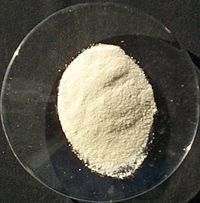
Photo from wikipedia
Abstract In this work, the two different polymorphs of Bi2O3, including α-Bi2O3 and β-Bi2O3, were fabricated by the post-calcined the precursor at 300 and 500 °C respectively. The pathway of… Click to show full abstract
Abstract In this work, the two different polymorphs of Bi2O3, including α-Bi2O3 and β-Bi2O3, were fabricated by the post-calcined the precursor at 300 and 500 °C respectively. The pathway of photocatalytic NO oxidation over the as-prepared photocatalyst (β-Bi2O3) was explored. The results showed that NO removal ratio on as-synthesis samples followed the order: β-Bi2O3 (32 %) > the precursor (13 %) > α-Bi2O3 (5 %). The ESR and in situ DRIFTS demonstrated that the superoxide ( O2−), as the main radical, can react with the absorbed NO on the surface of β-Bi2O3 to generate the final products NO3− and NO2−. Therefore, such findings reveal the possible photocatalytic pathway of NO oxidation on β-Bi2O3 based on in situ DRIFTS and give insight into understanding the polymorphism of Bi2O3 in efficient photocatalytic NO oxidation under the visible light.
Journal Title: Materials Research Bulletin
Year Published: 2020
Link to full text (if available)
Share on Social Media: Sign Up to like & get
recommendations!